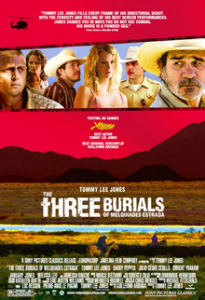
Theatrical release poster (c) 2005 www.impawards.com. Fair use for review

Theatrical release poster (c) 2005 www.impawards.com. Fair use for review
Lately, I’ve been reliving my childhood by renting classic Westerns from Netflix. I’m always looking for something new, so when I saw this movie characterized as a modern-day Western I had to see it. Furthermore, it won some major awards at Cannes in 2005. I was disappointed when the DVD arrived in a damaged state. When we got the replacement and finally watched it, I formed a theory on how this had happened. The previous renter probably threw it across the room.
I think that our opinion of a film depends greatly on our expectations. Three Burials stars one of our favorite actors, Tommy Lee Jones, and it was also his directorial debut. I wasn’t surprised that this was a message movie – the title implied as much – and I don’t mind that this message is at odds with my own beliefs. It could have been a great movie, with deep characters and a subtle plot. Instead, we got a heavy-handed screed about the brutality of the Border Patrol against saintly Mexican migrants. Tommy Lee, we expected better from you.
Three Burials was supposedly inspired by a real-life incident in which a migrant teenager was accidentally killed due to US military exercises on the border. There the similarity ends. Melquiades Estrada (played by Julio Cedillo), an “undocumented” immigrant living near Van Horn, Texas, is mistakenly shot and killed by border patrol agent Mike Norton (Barry Pepper.) Norton panics and buries Estrada in the desert. Two hunters discover the body after wild animals dig it up. Since Estrada has no known family, the county buries him in an indigent grave. When Estrada’s friend rancher Pete Perkins (Tommy Lee Jones) hears of this, he goes on a crusade to bring the killer to justice and to relocate Estrada’s body to his hometown in Mexico. This is source of the movie’s poetic and intriguing title. It could have been an amazing experience, but instead, it was infuriating.
It’s obvious that screenwriter Guillermo Arriaga has an ax to grind because he spends the first 45 minutes establishing what a horrible person Norton is. Through numerous confusing flashbacks, we see what a great guy Estrada was. Except for the folksy liberal Perkins, all the gringos in the movie are stupid, corrupt, or cruel. The Mexican characters are all honest, hard-working and generous despite their poverty. The low point was a contrived scene in which Estrada hooks up at a motel with Norton’s vain and selfish wife Lou Ann (January Jones.) I thought this might be a plot point, that the authorities might blame the shooting on jealousy, but nothing came of it.
The movie finally gets interesting when Perkins, disgusted that local authorities decline to prosecute Norton, takes matters into his own hands. He kidnaps Norton and forces him to dig up Estrada, and to accompany him into Mexico to bring the body back home. Though the movie doesn’t get any less strident, the cinematography is beautiful, and Perkins’ efforts to preserve his friend’s decaying body provide some dark humor. Likewise the ending provides a welcome plot twist, as Estrada’s life story as told to Perkins comes into question.
The Three Burials of Melquiades Estrada is a huge disappointment because the writer squanders the story’s interesting premise. Arriaga doesn’t trust audiences to get the point without hitting us over the head. No doubt “Three Burials” received its awards and critical acclaim due to its message alone. I give it 2 stars out of 5 for its name (I have a fetish for great titles) and the stunning scenic backdrops of its second half. Nevertheless, I wouldn’t recommend it except to film students and masochists.